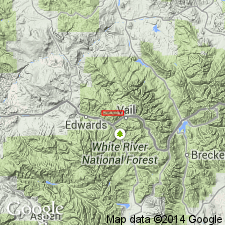
- Usage in publication:
-
- Eagle Valley Evaporite*
- Modifications:
-
- Named
- Dominant lithology:
-
- Mudstone
- Siltstone
- Gypsum
- AAPG geologic province:
-
- Eagle basin
Summary:
Named for gypsiferous sequence in Eagle Valley of Eagle River, near Avon, CO in Eagle basin. Type section located on interfluve west of Nottingham Creek, north side of Eagle River in secs 6 and 7, T5S, R81W, Eagle Co, CO. Is predominately gypsiferous mudstone and siltstone, usually light-colored. Contains bedded gypsum and a few cherty, dark gray limestone beds about 1 ft thick. Also includes reddish shale and siltstone. Contrasts with colors and massive ledges of Minturn and Maroon Formations. On west side of basin Minturn underlies and intertongues with the lower part, and overlies the upper part of Eagle Valley. Gypsiferous sequence thickens to west; 4,700 ft thick in a well in sec 4, T5S, R84W. Conformably overlain by Chinle Formation in Red Canyon. Age not clearly stated. Shown as intertonguing with Minturn Formation of Des Moines, or Middle Pennsylvanian age and with Maroon Formation of Pennsylvanian and Permian age. Deposited offshore in a more rapidly subsiding part of a trough while the coarse clastics of the Minturn and Maroon were deposited near the shores of the trough. Cross section. Replaces name "Eagle evaporite member of Minturn" of Murray (1958).
Source: GNU records (USGS DDS-6; Denver GNULEX).
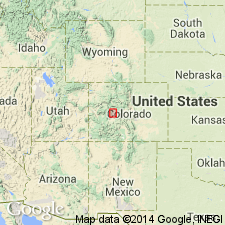
- Usage in publication:
-
- Eagle Valley Formation*
- Modifications:
-
- Redescribed
- Dominant lithology:
-
- Conglomerate
- Arkose
- Limestone
- AAPG geologic province:
-
- Eagle basin
Summary:
Redescribed--name changed from Eagle Valley Evaporite to Eagle Valley Formation in the central part of the Eagle basin where evaporites are absent or only locally present. Consists also of variegated fine-grained clastic rocks and a few dense unfossiliferous carbonate rocks which grade into coarse conglomerate, arkose, and fossiliferous limestone toward the basin margin. Is transitional between Minturn and Maroon Formations on the northeast side of the Eagle basin and the Gothic and Maroon Formations on the southwest side of the basin, but does not intertongue with the uppermost part of Maroon. Minturn, Eagle Valley, and Maroon overlie Belden Formation. Age not clearly stated. Pennsylvanian age probably intended.
Source: GNU records (USGS DDS-6; Denver GNULEX).
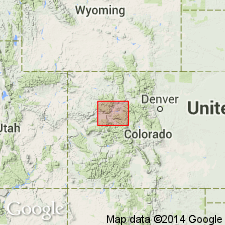
- Usage in publication:
-
- Eagle Valley Evaporite*
- Modifications:
-
- Age modified
- Overview
- AAPG geologic province:
-
- Eagle basin
Summary:
Abundant paleontological evidence for dating Eagle Valley. Collections of fossils of late Atoka and early Des Moines age made earlier by Bass and Northrop were from what is now called Eagle Valley Evaporite. Also Eagle Valley intertongues with the lower five-sixths of Minturn Formation which is of Des Moines age. Foraminifera and conodonts (listed) have been collected from Pennsylvanian and Permian to Middle Pennsylvanian, late Atoka and early Des Moines. A datum that corresponds to the top of Jacque Mountain Limestone Member of Minturn is recognized at Juniper Mountain and Buford in Morgan Formation and in Champlin No. 1 Black in sec 4, T5S, R84W at the Eagle Valley-Maroon contact. Lithology variable: gypsiferous mudstone and siltstone, and bedded gypsum, and a few limestones, to massive-bedded, coarse- to fine-grained, white to gray gypsum recognized on outcrop; shaly anhydrite, black and gray shale, dark siltstone, and haliferous shale recognized in subsurface. Nomenclature chart, areal extent maps, and cross sections.
Source: GNU records (USGS DDS-6; Denver GNULEX).
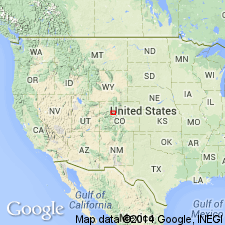
- Usage in publication:
-
- Eagle Valley Evaporite*
- Modifications:
-
- Overview
- AAPG geologic province:
-
- Eagle basin
Summary:
This paper describes a cross-stratified fine-grained sandstone in the upper clastic interval of Eagle Valley Evaporite in Red Canyon between Wolcott and Eagle on the Eagle River, Eagle Co, CO, in Eagle basin. The sandstone is predominantly parallel-stratified and of eolian origin, probably deposited in a dune apron. The rest of the sequence in Red Canyon includes black shale and evaporite. Presence of eolian deposits suggests changes in sea level and in depth of water in Eagle basin during Eagle Valley time (Middle Pennsylvanian).
Source: GNU records (USGS DDS-6; Denver GNULEX).
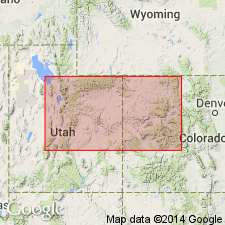
- Usage in publication:
-
- Eagle Valley Evaporite*
- Modifications:
-
- Age modified
- AAPG geologic province:
-
- Eagle basin
Summary:
Considered to range in age from late Desmoinesian to Virgilian. The Missourian to Virgilian age of the upper part has not been published previously. The upper nonevaporitic part of Eagle Valley was measured in the central part of the Eagle basin; this section lacked unconformities and was measured from the top of the highest, thick (60 m) gypsum bed. The upper Desmoinesian Jacque Mountain Limestone Member of the Minturn Formation, when traced from Minturn area into the middle of the basin, was found to immediately underlie the highest thick gypsum. Also, the upper Eagle Valley intertongues with lower part of Maroon Formation at the basin margins. The Maroon is considered late Desmoinesian to Wolfcampian. Relative constant sediment accumulation rate suggests Eagle Valley (which lacks diagnostic fossils) is late Desmoinesian to Virgilian age. Correlation chart. The upper part of Eagle Valley represents a continuum from sabkha and shallow water (regressive) to off-shore marine (transgressive) deposition.
Source: GNU records (USGS DDS-6; Denver GNULEX).
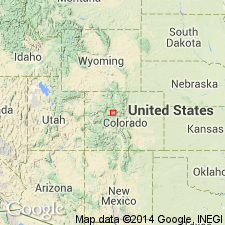
- Usage in publication:
-
- Eagle Valley Evaporite*
- Modifications:
-
- Revised
- AAPG geologic province:
-
- Eagle basin
Summary:
Two limestone members of the Minturn Formation--the Robinson and Jacque Mountain--can be traced west in six measured sections from the type Minturn across the Wolcott syncline, Eagle Co, CO, Eagle basin. In the vicinity of Avon and west across the syncline, the limestones are assigned to Eagle Valley Evaporite as Robinson Limestone Member (lower member) and Jacque Mountain Limestone Member (upper member). The Robinson is underlain by an unnamed clastic sequence of the Eagle Valley, and is overlain and separated from the younger Jacque Mountain by an unnamed clastic sequence of the Eagle Valley. Some place the top of the Eagle Valley at the top of Jacque Mountain, but this author places the upper Eagle Valley contact much higher at the top of the uppermost gypsum. Overlying formation is the Maroon. Several gypsum beds of the Eagle Valley extend east toward the type Minturn. Eagle Valley was deposited in central part of basin while the Minturn was being deposited in northeast part of basin. Is of Middle Pennsylvanian age.
Source: GNU records (USGS DDS-6; Denver GNULEX).
For more information, please contact Nancy Stamm, Geologic Names Committee Secretary.
Asterisk (*) indicates published by U.S. Geological Survey authors.
"No current usage" (†) implies that a name has been abandoned or has fallen into disuse. Former usage and, if known, replacement name given in parentheses ( ).
Slash (/) indicates name conflicts with nomenclatural guidelines (CSN, 1933; ACSN, 1961, 1970; NACSN, 1983, 2005, 2021). May be explained within brackets ([ ]).

